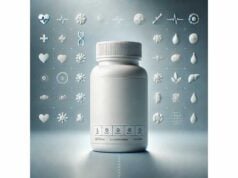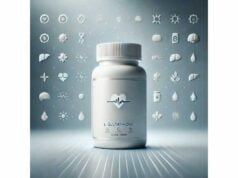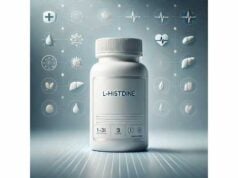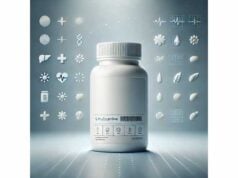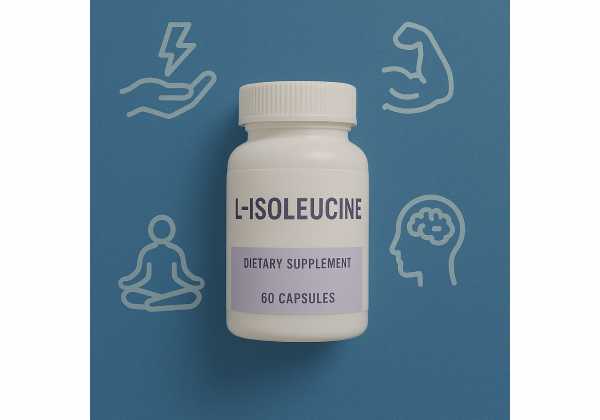
L-isoleucine is one of the three branched-chain amino acids (BCAAs), alongside leucine and valine. It is an essential nutrient: your body cannot make it, so you must get it from food or supplements. Inside muscle, isoleucine supports energy production during effort, helps maintain blood glucose by promoting uptake and use of glucose, and contributes to recovery after hard sessions. Beyond sport, it plays structural roles in proteins and supports hemoglobin formation and immune function. While leucine gets headlines for triggering muscle protein synthesis, isoleucine is the BCAA most associated with glucose handling and fuel use in skeletal muscle.
This guide explains what L-isoleucine does, who might benefit, how to dose it (alone or as part of BCAA or essential-amino-acid blends), what affects results (diet, timing, and training status), common mistakes to avoid, and safety considerations—including when not to supplement. You will also see a brief evidence snapshot to set realistic expectations.
Key Highlights
- Supports exercise by aiding muscle glucose uptake and contributing to energy during prolonged or intense efforts.
- Practical ranges: 1,300–1,500 mg/day from food meet baseline needs (≈19 mg/kg/day); supplements typically add 1–4 g/day isoleucine or 5–10 g BCAAs (2:1:1 ratio).
- Pair with protein-sufficient meals and carbohydrates around training for best results; split doses with food.
- Avoid unsupervised use if you have maple syrup urine disease, advanced kidney disease, or take levodopa; speak with your clinician first.
Table of Contents
- What is L-isoleucine?
- Does it work and for whom?
- How to take it: dosage and timing
- What changes your results
- Mistakes and troubleshooting
- Side effects, interactions, and who should avoid
- Evidence snapshot and research gaps
What is L-isoleucine?
An essential branched-chain amino acid (BCAA).
Isoleucine, leucine, and valine share a branched side chain and are metabolized largely in skeletal muscle rather than the liver. Because isoleucine is essential, daily intake from food is mandatory; body pools turn over continuously through normal protein synthesis and breakdown.
Core physiological roles.
- Fueling exercise: During prolonged or intense effort, isoleucine can be transaminated and oxidized for energy, sparing some glycogen.
- Glucose handling: Isoleucine helps increase glucose uptake into muscle and supports its use for energy. This is particularly relevant in glycogen-depleting or high-volume training states.
- Structural and hematologic roles: It is incorporated into new muscle proteins and contributes to hemoglobin synthesis, indirectly influencing oxygen transport.
- Immune support: Adequate essential amino acids, including isoleucine, help maintain immune cell function under stress.
Dietary sources.
Protein-rich foods are the most reliable providers: poultry, beef, fish, eggs, dairy (whey, Greek yogurt, cottage cheese), soy foods (tofu, tempeh), legumes (lentils, chickpeas), and whole grains like oats. Balanced meals with 25–40 g high-quality protein typically supply 1–2 g isoleucine without supplements.
Baseline requirements.
International guidance places the adult mean requirement for isoleucine around 19 mg/kg/day. For a 70-kg adult, that’s roughly 1.3 g/day, easily achieved by a protein-adequate diet. Athletes, older adults, and those in energy deficit may benefit from higher total protein rather than isolated isoleucine, but targeted isoleucine can still be useful in specific scenarios (see below).
Supplement formats.
- Standalone L-isoleucine powder/capsules.
- BCAA blends (commonly 2:1:1 leucine:isoleucine:valine).
- Essential amino acid (EAA) mixes that include all nine essential amino acids.
- Whey or complete proteins, which already deliver all essentials in natural ratios and often outperform free BCAAs for muscle protein synthesis.
Bottom line: Isoleucine is an essential, workhorse amino acid with distinct fuel and glucose-uptake roles in muscle. Most people meet needs with a balanced diet; supplementation is about context and timing, not replacing whole proteins.
Does it work and for whom?
Endurance and high-volume training.
In long or glycogen-taxing sessions, isoleucine contributes to energy and helps muscles pull glucose from blood more efficiently. Practically, athletes sometimes notice steadier energy late in sessions and less “heavy-leg” fatigue when peri-workout nutrition includes amino acids plus carbohydrate. These effects are modest next to sufficient carbs and fluids, but they can be noticeable during multi-hour days or back-to-back workouts.
Strength and hypertrophy.
Leucine is the primary amino acid that triggers muscle protein synthesis (MPS) via mTOR, but isoleucine is not redundant. It supports the energetic side of training by enhancing glucose uptake and contributing substrate. In lifters who already hit 1.6–2.2 g/kg/day protein, extra free BCAAs add little to MPS. Where isoleucine may help is around two-a-day training, during cuts with low energy availability, or when training fasted—situations where glucose management matters and meals are suboptimal.
Team sports and intermittent efforts.
Stop-start sports (football, basketball, hockey) combine sprints with active recovery. Isoleucine can be part of a peri-game plan to smooth blood glucose dips, especially when combined with a sports drink and sufficient sodium. Again, expect support, not a performance leap.
Healthy aging and clinical contexts.
Adequate total protein remains the highest-impact lever for older adults. For those who struggle to consume enough high-quality protein at meals, an EAA mix may beat isolated BCAAs by providing all essentials—including isoleucine—in the proportions muscles need. In specialized clinical care (e.g., bed rest, illness), amino acid support is managed by clinicians; do not self-prescribe high-dose BCAAs for medical conditions.
Body composition and weight management.
Any body-composition benefits from isoleucine arrive indirectly via better training quality and recovery plus higher overall protein intake. Free isoleucine alone does not melt fat. Pairing adequate protein with resistance training, sufficient fiber, sleep, and step count remains superior to chasing one amino acid.
Metabolic health nuance.
Short-term lab and animal data indicate isoleucine can lower postprandial glucose and increase muscle glucose uptake. Population studies, however, link chronically elevated BCAAs to insulin resistance risk. These findings are not contradictory: context matters. In active people meeting protein needs, moderate peri-workout BCAA use is generally fine. For those with metabolic disorders, any supplement plan should be supervised to fit into an overall nutrition and activity program.
Who is most likely to notice a benefit?
- Athletes with high training volume or two-a-day schedules.
- Individuals who train early and cannot tolerate large pre-workout meals.
- People in a cut or low-energy phase who still want to sustain session quality.
- Older trainees who use EAA blends to reach per-meal protein thresholds when appetite is low.
How to take it: dosage and timing
From food first.
Hit a daily protein target of 1.2–2.0 g/kg/day (higher end for athletes or during fat loss). This usually supplies 1.3–3 g/day isoleucine without any powders.
Standalone L-isoleucine (if you specifically target glucose support).
- Start: 500–1,000 mg with a carb-containing meal or 15–30 minutes before training.
- Common range: 1–2 g/day, split in 1–2 doses.
- Short cycles: Use around demanding blocks (e.g., tournament weeks) for 2–8 weeks; assess response and GI tolerance.
As part of BCAA blends.
- Typical formula: 2:1:1 leucine:isoleucine:valine.
- Serving: 5–10 g BCAAs delivers 1.25–2.5 g isoleucine.
- Timing: Sip in the 30 minutes pre-workout and during training, especially if sessions exceed 60–75 minutes or occur fasted. Combine with 20–40 g carbohydrate and electrolytes for best support.
As part of EAA mixes or complete proteins.
- EAA mixes (10–15 g) or whey protein (20–30 g) already deliver sufficient isoleucine plus all other essentials. For hypertrophy or recovery, these are generally superior to isolated BCAAs.
- Per-meal trigger: Aim for 2–3 high-quality protein meals each providing ≥2–3 g leucine (whey, dairy, eggs, lean meats, soy), which naturally includes ~1–2 g isoleucine.
Training-day examples.
- Morning lifter: 5–10 g BCAAs (2:1:1) + 20–30 g carbs before lifting or 20–30 g whey if tolerated.
- Endurance long run/ride: 5–10 g BCAAs in a bottle with 30–60 g carbs per hour; optional extra 500–1,000 mg isoleucine pre-start if GI-tolerant.
- Two-a-day athlete: Small pre-session protein + carbs; BCAAs or EAA sip during; complete meal within 60–90 minutes after.
Hydration and electrolytes.
Isoleucine is not a rehydration salt. Pair with sodium (300–600 mg/h in heat, individualized) and consistent fluid intake guided by thirst and sweat rate.
When to avoid or pause.
If you experience GI upset, headache, or jitters when stacking multiple ergogenics (caffeine, beta-alanine, BCAAs), simplify and re-introduce one at a time. Pause 1–2 weeks every couple of months if using large total amino acid loads to check whether the supplement is still pulling its weight.
What changes your results
Total protein intake.
Results from isoleucine hinge on your baseline. If daily protein is low, you’ll get bigger returns by bringing meals up to target than by adding free BCAAs. If protein is already adequate, small isoleucine or BCAA additions are fine-tuning tools.
Carbohydrate availability.
Isoleucine complements—not replaces—carbohydrate. For intense or long sessions, target 3–12 g/kg/day carbs depending on volume, with 30–60+ g/hour during efforts over 60–90 minutes. Without carbs, isoleucine’s glucose-uptake support has little substrate to work on.
Timing and split dosing.
Muscle is most receptive around training. Small, repeated exposures of isoleucine (via protein-rich meals and/or peri-workout sips) generally beat one big bolus. Splitting doses helps GI comfort too.
Age, sleep, and energy balance.
- Older adults: Anabolic responsiveness is blunted. Prioritize complete proteins or EAA mixes rather than isolated BCAAs.
- Sleep-deprived or dieting: Stress hormones and low glycogen raise perceived effort; isoleucine can help on the margins, but restoring sleep and fueling properly are higher yield.
Training status.
Beginners gain quickly from the training itself; supplements matter least. As you get closer to your ceiling, nutrition precision (including amino acid timing) can produce small, meaningful differences in quality and recovery.
Matrix effects in blends.
Many products add caffeine, taurine, or electrolytes. If you feel “wired” or queasy, check total stimulant load and simplify your stack. For skin flush or tingling, that’s likely beta-alanine, not the BCAAs.
Individual response.
Track session RPE, time to fatigue, rep quality, and next-day soreness. Keep the rest of your routine steady for 2–3 weeks when testing isoleucine so you can credit or rule it in fairly.
Mistakes and troubleshooting
Mistake 1: Using BCAAs instead of fixing protein.
If you’re under-eating protein, BCAAs are like patching a tire instead of replacing it.
Fix: Bring daily protein to 1.2–2.0 g/kg/day, then consider isoleucine fine-tuning.
Mistake 2: Megadosing free aminos.
More grams are not always better. Large BCAA loads can upset the GI tract and may not improve performance.
Fix: Stay near 5–10 g BCAAs around training or 1–2 g standalone isoleucine per dose.
Mistake 3: Ignoring carbohydrate timing.
Going low-carb for hard sessions undermines the very pathway isoleucine supports.
Fix: Add 30–60 g carbs per training hour as needed; eat a carb-protein meal within 2 hours after.
Mistake 4: Expecting isoleucine to boost muscle protein synthesis like leucine.
Leucine is the trigger; isoleucine is the fuel handler.
Fix: Use complete proteins or EAA blends to cover MPS; use isoleucine to smooth fuel use.
Mistake 5: Overlooking interactions.
BCAAs compete with certain molecules for transport into the brain and across the gut wall.
Fix: If you take levodopa or have a metabolic condition, get medical guidance; separate dosing from critical meds.
Troubleshooting quick hits
- Stomach upset: Halve the dose, sip slowly with water, and take with food.
- No perceived benefit: Ensure sleep and calories are adequate; try peri-workout timing; consider EAA instead of BCAAs.
- Cramping in heat: That’s usually electrolyte or fluid balance—add sodium and monitor sweat rate.
Side effects, interactions, and who should avoid
Typical tolerability.
At common doses, isoleucine is well tolerated. Possible effects include mild nausea, bloating, or GI discomfort, especially with large boluses or when training intensely in the heat. Splitting doses with meals minimizes issues.
Neurological transport competition.
BCAAs share transporters across the gut and blood-brain barrier with aromatic amino acids (tyrosine, tryptophan) and certain drugs. High BCAA intakes may reduce brain tryptophan availability transiently, which some athletes find helpful (lower central fatigue) and others find neutral.
Medication considerations.
- Levodopa: Large neutral amino acids can compete for transport; take under medical guidance and separate doses if advised.
- Diabetes medications: Isoleucine may modulate glucose disposal; monitor glucose closely when changing supplements and discuss with your care team.
- Surgery: Stop non-essential supplements 1–2 weeks before elective procedures unless your surgeon approves them.
Medical conditions.
- Maple syrup urine disease (MSUD): A genetic defect in BCAA breakdown; avoid supplemental BCAAs without specialist supervision.
- Kidney disease: Extra amino acid loads may not be appropriate; follow clinician guidance.
- Pregnancy and breastfeeding: Prioritize whole-food protein; avoid high-dose BCAA powders unless your clinician recommends them.
Long-term metabolic context.
Epidemiology links chronically elevated BCAAs with insulin resistance. This does not mean normal dietary intakes are harmful; it highlights that dose, duration, and overall lifestyle matter. For most active individuals eating balanced diets, moderate, targeted isoleucine use around training is reasonable.
Allergies and additives.
Some flavored powders contain artificial sweeteners or colorants that can cause GI or skin reactions in sensitive people. Choose simple formulas, check for third-party testing, and avoid proprietary blends that hide exact amounts.
When to stop and seek advice.
Persistent GI pain, unexplained fatigue, palpitations, neurologic symptoms, or any reaction after starting high-dose amino acids warrants stopping the product and consulting a healthcare professional.
Evidence snapshot and research gaps
What is well supported.
- Isoleucine is essential and must come from the diet. Adult baseline requirements are about 19 mg/kg/day, achieved with normal protein-adequate meals.
- In mechanistic and animal models, isoleucine increases muscle glucose uptake and can lower circulating glucose without raising insulin, suggesting an insulin-independent pathway in muscle.
- For recovery and training quality, total daily protein and carbohydrate availability are higher-leverage factors than free BCAA dosing.
What the athlete can expect today.
- Small, context-dependent benefits for session quality and late-workout energy, especially during long or fasted sessions and two-a-days.
- If hypertrophy is the primary goal and protein intake is already sufficient, complete proteins or EAA mixes remain more reliable than free BCAAs.
What is mixed or under study.
- Performance outcomes: Meta-analyses show variable effects of BCAA supplementation on soreness and performance, with better signals in protocols using eccentric damage and in those with low baseline protein.
- Metabolic health: Elevated fasting BCAAs correlate with insulin resistance risk; intervention data are evolving and emphasize overall diet, weight, and activity as dominant levers.
- Standalone isoleucine in humans: Promising for postprandial glucose modulation, but dose-finding and long-term trials in diverse populations are limited.
Research gaps to close.
- Dose–response trials of isoleucine alone in humans (glucose, performance, and recovery endpoints).
- Comparisons of EAA vs BCAA vs complete protein under matched protein totals and real-world training schedules.
- Long-term safety of chronic high BCAA intakes in different metabolic phenotypes.
- Personalization: How training age, sex, age, and microbiome differences influence response to isoleucine.
Practical take-home: Anchor your plan in adequate protein and carbs, consider EAA or complete proteins as the foundation, and use isoleucine or BCAA surgically around training if you identify a clear use case and good personal response.
References
- Protein and Amino Acid Requirements in Human Nutrition: Report of a Joint WHO/FAO/UNU Expert Consultation 2007 (Guideline)
- Isoleucine, a blood glucose-lowering amino acid, increases glucose uptake in rat skeletal muscle in vivo 2005 (Study)
- Branched-Chain Amino Acids and Insulin Resistance, from Association to Causation 2022 (Systematic Review)
- Oral Branched-Chain Amino Acids Supplementation in Athletes—A Meta-Analysis of Randomized Controlled Trials 2022 (Meta-analysis)
- Maple Syrup Urine Disease 2020 (GeneReviews)
Disclaimer
This content is educational and does not replace personalized medical advice. Consult a qualified healthcare professional before starting L-isoleucine or any amino acid supplement—especially if you have diabetes, kidney disease, hypertension, or a metabolic disorder such as maple syrup urine disease; if you are pregnant or breastfeeding; or if you take prescription medications (including levodopa). Stop use and seek care if you experience persistent gastrointestinal symptoms, palpitations, unusual fatigue, or any concerning reaction.
If you found this article useful, please consider sharing it on Facebook, X (formerly Twitter), or your preferred platform, and follow us for more evidence-guided fitness and nutrition insights. Your support helps us continue producing high-quality, people-first content.

